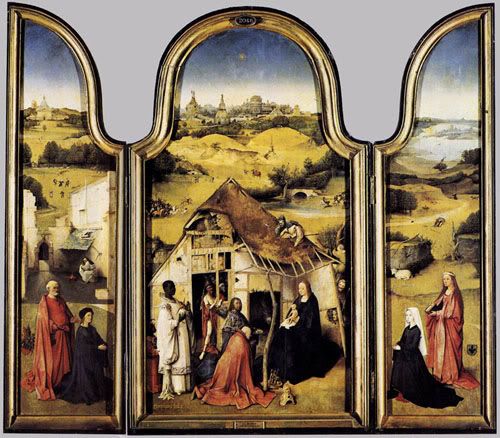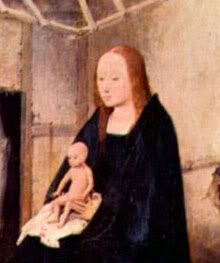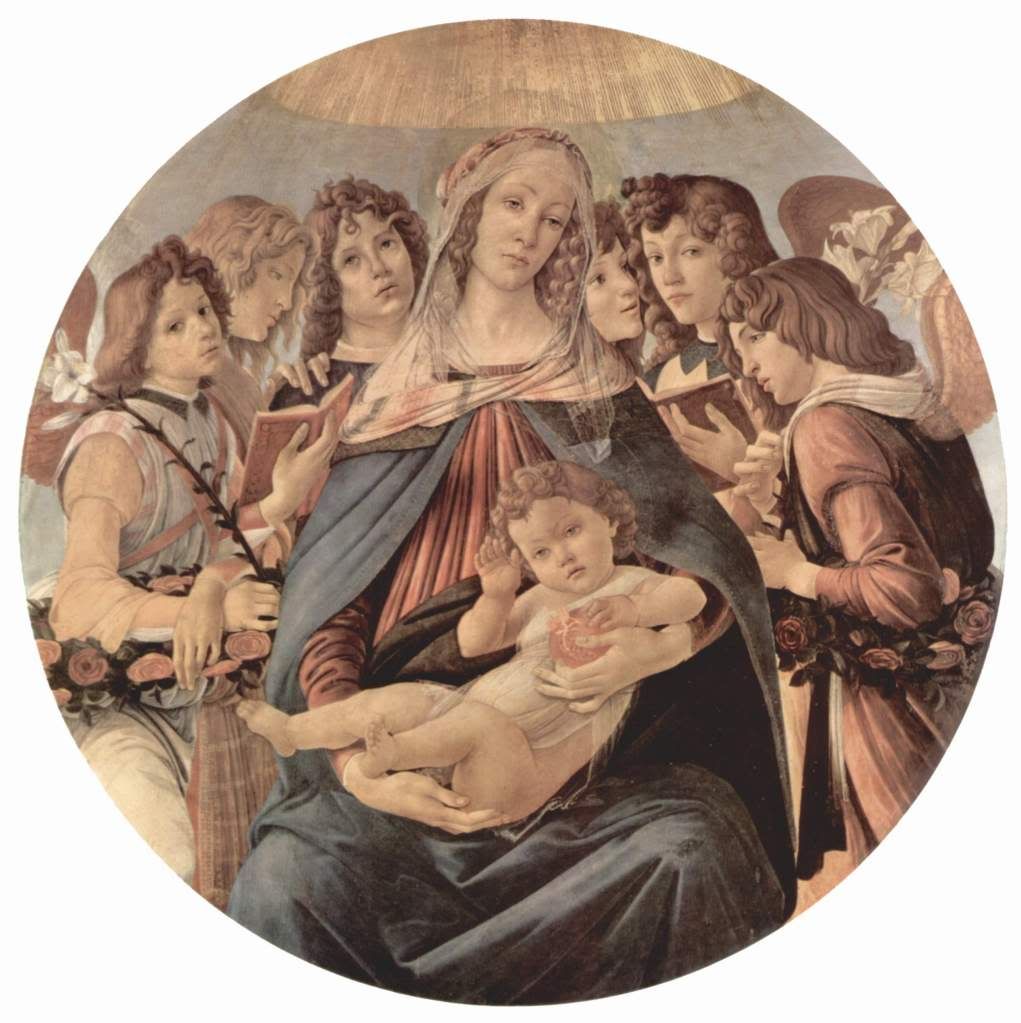The Prado Epiphany (interior), Hieronymus Bosch, c. 1500.
Oil on panel. Museo del Prado, Madrid.
My name is Adam Ruvola and I am a senior at SUNY Oneonta working towards my BS in Fine Art with an Art History concentration. I am finally starting the blog associated with my independent study of Hieronymus Bosch a few weeks after I had originally intended. Many factors contributed to the delay, with the most major (and most important) being the birth of my son, Desmond Frederick Ruvola. Desmond was born on July 9th, two months early. He is growing and doing wonderfully and has been since he was delivered. He came out breathing without assistance, which is nothing short of a miracle I hear. I am discussing this in such length due to more than parental pride. Having first hand experience of a newborn, especially a preemie, has given me an additional insight into Bosch's Prado Epiphany, pictured above.
In a short essay on the Prado Epiphany (which I will post here soon) that I wrote last April for Dr. Allen Farber's Language of the Visual Arts course I refer to Bosch's presentation of the Christ Child as "doll-like" and as a "-mannequin-Christ", a quality that I ventured might be related to a potential source of inspiration for this Epiphany scene, performances of the Nativity and Epiphany by Chambers of Rhetoric in Bosch's home city of 's-Hertogenbosch. As I state in my essay, it seems quite natural that such a performance would utilize a doll for the role of Christ for logistical purposes, the same as any modern Christmas pageant.
While I still believe dramatic performances contribute to the visuals of this and other Bosch paintings, focusing solely on this factor limits the complexity of Bosch's narrative abilities and symbol synthesis. And that would always be a mistake.
In my essay I also discuss the somewhat subtle hierarchical scaling of the Virgin in this painting. The tiny and frail form of the Christ Child might in part be being used to enhance this quality, more so as his pale, naked form contrasts the deep blue/black of Mary's robes. This might relate to the medieval and Renaissance era importance placed on the Virgin, in this instance as the Throne of Wisdom, particularly for Bosch and his most likely patrons as members of the Illustrious Brotherhood of Our Blessed Lady.
But let's focus on Bosch's depiction of the Christ Child. I can think of few if any images of the Madonna and Child with the Holy Infant appearing as small or newly born as this one (which certainly does not mean that none exist, I just can't bring any to mind). Many medieval depictions, where naturalistic depiction was not the intent, feature a child that looks more like a miniature man. Works more contemporary with Bosch seem to more frequently show a Christ Child that is robust and quite a bit older, as in Botticelli's Madonna of the Pomegranate.
Madonna of the Pomegranate, Sandro Botticelli, c. 1487
Tempera on panel. Uffizi, Florence, Italy.
Of course one of the differences between these images are the details of what they are depicting. While the Prado Epiphany features a Throne of Wisdom image it is a narrative painting, showing a specific moment in time. The Madonna of the Pomegranate is timeless, featuring instead the eternal and ideal qualities of the Virgin and the Christ Child.
Which brings me back to Desmond and his premature birth. There is a door connecting my bedroom and his nursery on which hangs a poster of the central panel of the Prado Epiphany. Since writing my essay I have spent much bottle-feeding time looking and thinking about this painting, and while holding my tiny child up in a seated position on my lap the qualities of Bosch's depiction of the Christ Child that I earlier missed became rather clear. As tiny as Christ appears on his Mother's vast lap, he looks to my eye to be sitting upright on his own. Bosch's newly born Christ is small but he is preternaturally mature, mentally, physically and of course spiritually, as he looks upon his royal visitors as the King of Kings.
This to me shows the canniness of Bosch's symbol crafting. The fragility of a newborn child imbued with the supernatural presence of the Son of God. Neither quality would read as potently were they separated. Taking this consideration even further, is it possible that Bosch is purposefully showing Christ as a preterm baby? It is hard to conceive of a child born early surviving in the fifteenth century, as to this day it is an alarming experience involving a great deal of technology and personnel. But they must have occurred, and while the death rate for such births must have been astronomical, there must also have been a very rare number who survived. And they would have been considered miraculous. It is purely speculation on my part with no possible means of confirming or denying, but this incorporation of the experienceable into the depiction of the metaphysical for the purpose of making it more viscerally relatable would not be outside the scope of Bosch's unique manner of narrative symbolism.
I will try to post my original essay within the next few days.




This is fantastic! A new Adam blog is a great way to start the week. I look forward to reading more.
ReplyDelete-D*